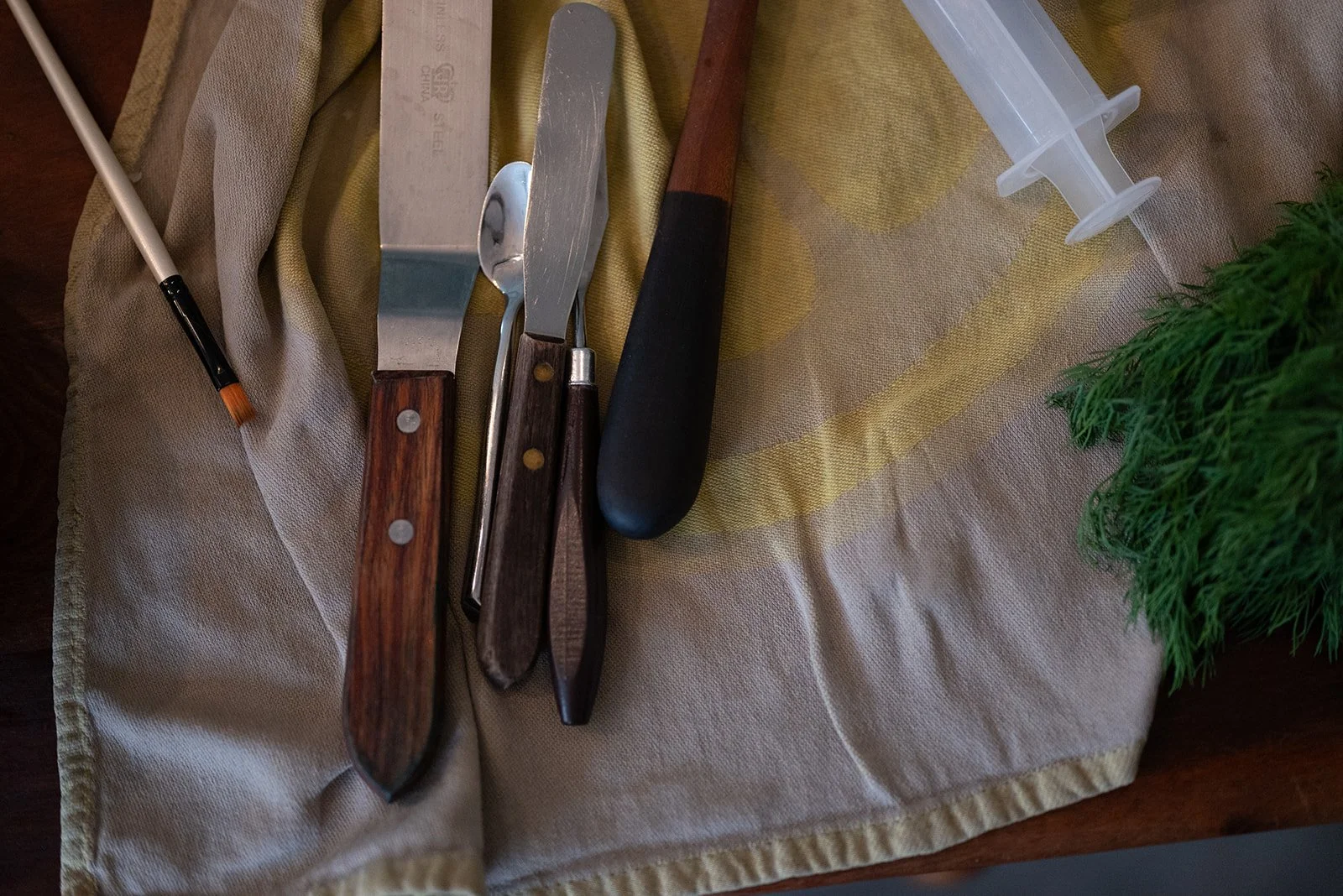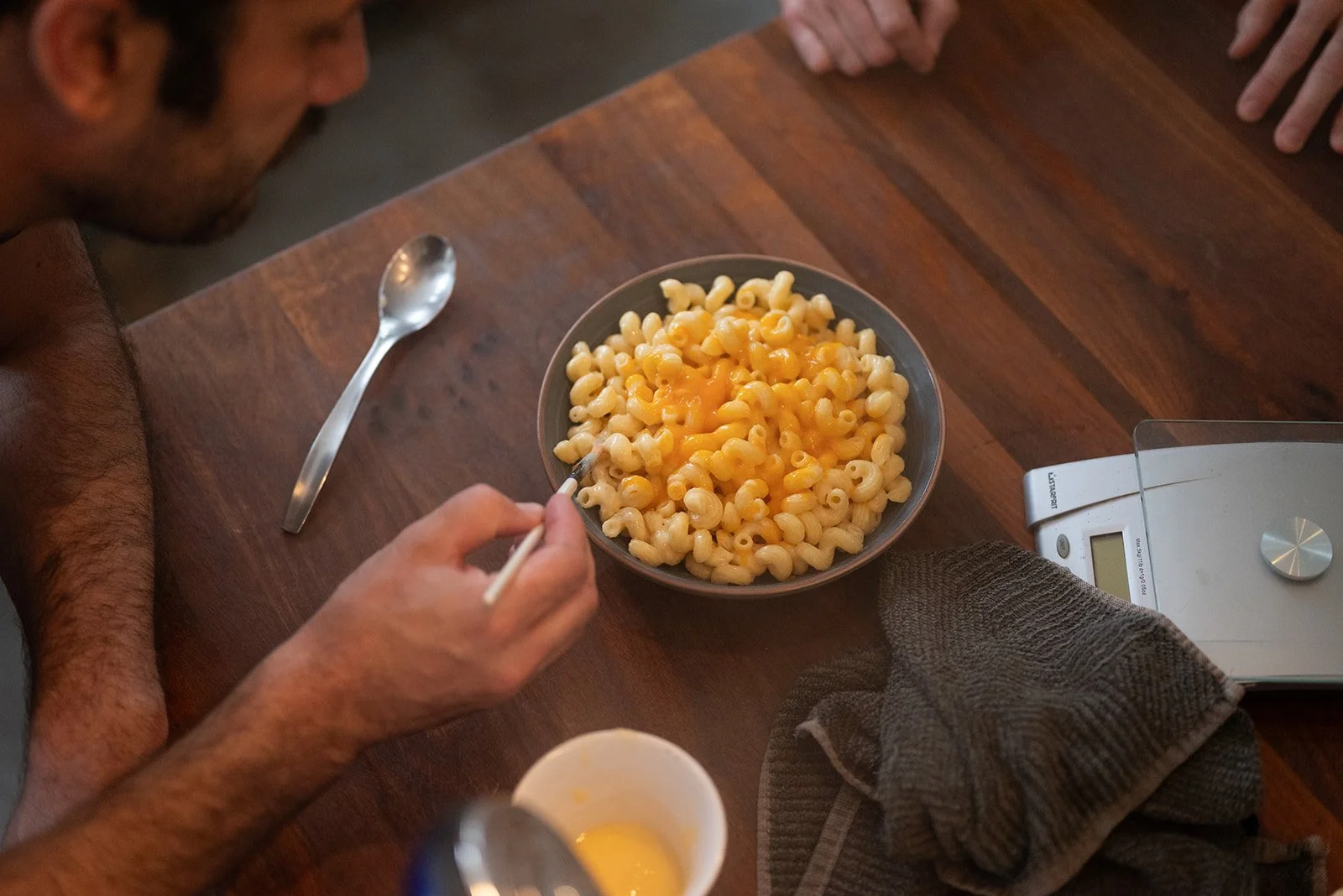A two-day journey into the world of food photography, creative direction, and yes—hand modelling.
When Amanda, our founder and creative director at Eye Candy Design, first told me I'd be the hand model for the Pebbles frozen meals photoshoot, my excitement was immediate. But so was the reality check: I needed to book a professional manicure—my first in years, since I usually do my own nails. For a photoshoot where my hands would be the focus, this wasn't optional. But between the manicure appointment and the shoot prep, one thing was clear: this was going to be one of the most fun projects we do all summer.
Spoiler alert: I was absolutely right.
Setting the Stage: Common Ground Farm in St. Thomas
This past summer, Eye Candy Design had the incredible opportunity to work with Pebbles, a beloved family restaurant, on repackaging their line of frozen meals. With 16 SKUs total—a mix of hearty entrees and convenient sides—we knew this project would require a comprehensive creative approach and a food photography partner who could bring our vision to life.
That's where Steve Domjancic from Gotham Studios came in. We'd worked with Steve before, so I knew we were in good hands. What I didn't know was just how much I'd learn over those two days at the farm.
Common Ground Farm provided the perfect backdrop for what we were trying to achieve. Pebbles isn't just any frozen food brand—it's a family restaurant with roots in the community, and their frozen meals are an extension of that warm, homestyle cooking their customers love. The farm's rustic setting and charming farmhouse kitchen gave us exactly the ambiance we needed: authentic, welcoming, and unpretentious.
The Creative Vision: Homestyle in a Heartbeat
The challenge was clear: how do you make frozen meals feel warm, inviting, and genuinely appetizing? How do you communicate quality, comfort, and convenience all in a single image?
Amanda's direction was brilliant in its simplicity. We'd shoot the meals plated and ready to eat, held in hands to emphasize the human connection and homestyle feel. The colour palette would be warm and inviting—rich burgundy for the Pebbles brand colour, natural wood tones, and pops of colour from a mustard yellow apron that added just the right amount of visual interest without overwhelming the food.
Since we were photographing three different product types—full entrees, meats and individual sides—we developed three distinct but complementary styling approaches.
Day One: Learning What Food Styling Really Means
I thought I understood food photography before this shoot. I'd seen plenty of gorgeous food images, worked on food and beverage branding projects, and even attended a few photoshoots. But I'd never worked with a dedicated food stylist before, and let me tell you, Andrew Bullis completely changed my perspective on what goes into making food look irresistible.
My biggest surprise? Just how much effort and time goes into preparing each dish before it's camera-ready. We're talking about 1-2 hours per setup. For a single shot.
I watched Andrew work with the kind of precision I'd only seen from surgeons on medical dramas. Every element had to be considered: the way the BBQ sauce glistened on the farmer sausage, the perfect golden sheen on the mac and cheese, the vibrant green of each individual pea, the appetizing glaze on the chicken.
One technique that particularly fascinated me was watching Andrew steam the chicken to make it look shinier and more appetizing. It seems so obvious in retrospect but it's not something that would ever occur to someone outside the industry.
The food stylist's toolkit was like nothing I'd ever seen. Tweezers for placing individual elements. Brushes for applying oil or glaze. Tiny spray bottles for adding moisture. Cotton swabs for cleaning up errant sauce drips. It was meticulous, methodical, and absolutely mesmerizing to watch.
My Moment in the Spotlight (Sort of)
Now, about that hand modelling gig.
I genuinely was excited about it, which probably sounds ridiculous to anyone who's never done it. But there's something fun about being directly part of the creative output, even if it's just your hands that make the final cut.
The manicure was non-negotiable. We were going for a natural, neutral look—nothing that would distract from the food or clash with the warm colour palette. We chose a soft, clean nude shade that would photograph well without drawing attention.
What I didn't fully appreciate until I was actually on set was how physically demanding hand modeling could be. You're holding a position—sometimes an awkward one—for extended periods while Steve got the lighting just right, while Andrew made micro-adjustments to the food, while Amanda assessed the composition from every angle.
"Tilt your wrist slightly to the left." "Can you spread your fingers just a bit more?" "Hold that position... and hold... almost there..."
My arms got surprisingly tired. But every time I saw the shot come together on Steve's monitor, it was absolutely worth it. There's something incredibly satisfying about seeing your own hands—hands that had been typing emails and working on mock-ups and holding coffee cups all year—now cradling a beautifully styled plate of food that would soon appear on packaging in freezer aisles.
Wearing Multiple Hats: From Hand Model to Production Assistant
Between my hand modelling duties, I got to assist Steve with various aspects of the photography setup. I held reflectors and lights to help control shadows and highlight the food's best features. I helped arrange elements in the scene according to Amanda's direction—adjusting the placement of the checkered napkin, positioning the fork just so, making sure the mustard yellow apron was visible but not dominating the frame.
This hands-on involvement (pun intended) gave me an even deeper appreciation for the technical complexity of food photography. Lighting, in particular, is an art form unto itself. Too harsh, and the food looks unappetizing. Too soft, and it lacks dimension. Steve's expertise in finding that sweet spot—where the farmer sausage had texture, the vegetables looked fresh, and the mashed potatoes appeared creamy and inviting—was impressive to witness up close.
Working alongside Steve also reinforced something I already knew but sometimes forget in the rush of project deadlines: great creative work takes time. You can't rush excellence. Those 1-2 hours per setup weren't wasted time—they were an investment in creating images that would sell products, represent the brand with integrity, and make people genuinely hungry when they walked past the freezer section.
The Power of Strong Creative Direction
I have to take a moment here to talk about Amanda's role in all of this, because her leadership is what made the entire shoot not just successful, but smooth.
Amanda has this gift for seeing the big picture while staying attuned to the smallest details. She'd review each shot with a critical eye, making suggestions that elevated the composition without derailing the momentum. She kept us on schedule—no small feat when you're dealing with 16 different SKUs over two days—while never making anyone feel rushed.
More importantly, she created an environment where everyone could do their best work. Steve had the freedom to explore different lighting setups. Andrew could take the time he needed to perfect each element. I felt comfortable asking questions and learning as we went. The Pebbles owners, who were present for much of the shoot, could see their products being treated with care and creativity.
That's the mark of an excellent creative director: making everything look effortless when, in reality, there's an enormous amount of planning, decision-making, and problem-solving happening behind the scenes.
Client Collaboration: When Owners Are On Set
Speaking of the Pebbles owners—having clients present during a photoshoot can sometimes add pressure, but in this case, it actually enhanced the experience. You could see their pride in their products and their genuine excitement as they watched their frozen meals transform into compelling visual stories.
They seemed to really enjoy the process, asking questions, offering input when appropriate, and trusting our creative expertise when we made recommendations. There's something special about that kind of collaborative relationship, where both design studio and client are working toward the same goal with mutual respect and enthusiasm.
Every time we completed a setup and reviewed the shots together, you could see their faces light up. These were their recipes, their family restaurant's legacy, now being presented in a way that honoured both the quality of the food and the care that goes into preparing it.
Day Two: Finding Our Rhythm
By the second day, we'd hit our stride. Everyone knew their role, understood the creative vision, and had developed a shorthand that made the process more efficient without sacrificing quality.
The variety across the 16 SKUs kept things interesting. Each product had its own personality, and its own composition challenges. The sides required a different approach than the entrees, and we had to maintain visual consistency while allowing each product to shine in its own right.
I found myself anticipating what Steve would need before he asked. I could see when Amanda was considering a composition adjustment before she vocalized it. Andrew's styling process became less mysterious and more logical as I watched him work through different dishes.
This is what I love about creative projects—that moment when a group of talented people, each bringing their own expertise, starts functioning as a cohesive unit. It's collaborative creativity at its finest.
The Bigger Picture: Why Food Photography Matters in Packaging Design
Working on the Pebbles project reminded me why food photography is such a critical component of packaging design, especially for retail.
When consumers are standing in the freezer aisle, they're making split-second decisions based almost entirely on visual cues. The photography on the package is essentially making a promise: "This is what you're going to eat, and it's going to be delicious."
That promise needs to be authentic. The food needs to look like food, not some artificial, over-stylized version that bears no resemblance to what's actually inside the package. At the same time, it needs to be appetizing enough to trigger that impulse to reach for the product, put it in the cart, and take it home.
Finding that balance—authentic but appealing, realistic but crave-worthy—is exactly what we achieved with the Pebbles shoot. Those 1-2 hours per setup ensured that every shot represented the product honestly while presenting it in its absolute best light.
Lessons Learned and Gratitude
Looking back on those two days at the farm, I'm struck by how much I learned and how grateful I am for the experience.
I learned that food styling is an incredibly specialized skill that requires patience, precision, and a deep understanding of how food behaves under studio lights. I learned that hand modelling is more physically demanding than it looks. I learned that great food photography requires not just technical expertise, but also creative vision and meticulous attention to detail.
Most importantly, I learned—or perhaps relearned—the value of collaborating with talented, passionate creative professionals. Steve's photography expertise, Andrew's styling prowess, Amanda's creative direction, and yes, even the Pebbles owners' enthusiasm and trust all combined to create something greater than any of us could have achieved individually.
Why Photoshoots Are Usually Fun (And This One Especially)
There's an energy to photoshoots that's hard to replicate in other aspects of studio work. You're creating something tangible, seeing ideas transform into reality in real-time, problem-solving on the fly, and collaborating intensively with people who genuinely care about producing excellent work.
The Pebbles shoot had all of that, plus the charm of Common Ground Farm's setting, the novelty of working with a food stylist for the first time, the fun of being a hand model (manicure and all), and the satisfaction of seeing a comprehensive repackaging project come together exactly as envisioned.
When I see those new packaging designs I'm reminded of why I love working in creative marketing. It's not just about making things look good (though that's certainly part of it). It's about telling stories, creating connections, and helping brands communicate their value in ways that resonate with real people.
The Takeaway
If you're considering a food photography project for your brand—whether it's for packaging, advertising, or digital content—here's what I'd tell you based on this experience: Invest in the right team. A skilled food photographer, an experienced food stylist, and strong creative direction aren't luxuries, they're necessities for achieving results that truly showcase your products.
Be patient with the process. Those hours aren't wasted time, they're what separates amateur food photography from professional, sales-driving imagery.
Choose your location thoughtfully. The right setting can elevate your creative concept and provide authentic context for your products.
Trust your creative partners. Whether it's a design studio like Eye Candy Design or the individual photographers and stylists you work with, creative professionals bring expertise and perspective that can transform good ideas into exceptional execution.
And maybe, if you're lucky, book that manicure and embrace the chance to be part of the creative output yourself. You never know, it might just be one of the most fun things you do all summer.
Behind the Scenes Photo Credit: Jorge Polio Photography
Interested in learning more about Eye Candy Design's approach to food photography, packaging design, and creative direction? We'd love to hear about your project. From concept development to art direction to hands-on production support (literally), we bring brands to life through thoughtful, strategic creative work.








